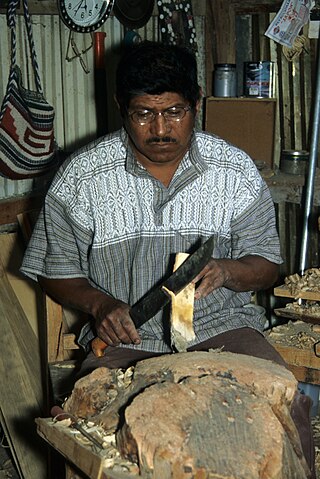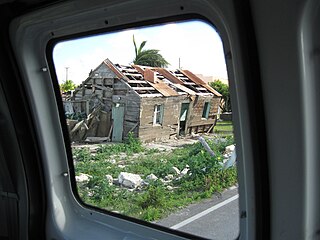
A machete is a broad blade used either as an agricultural implement similar to an axe, or in combat like a long-bladed knife. The blade is typically 30 to 66 centimetres long and usually under 3 millimetres thick. In the Spanish language, the word is possibly a diminutive form of the word macho, which was used to refer to sledgehammers. Alternatively, its origin may be machaera, the name given by the Greeks and Romans to the falcata. It is the origin of the English language equivalent term matchet, though this is rarely used. In much of the English-speaking Caribbean, such as Jamaica, Barbados, Guyana, Grenada, and Trinidad and Tobago, the term cutlass is used for these agricultural tools.

The Venceremos Brigade is an international organization founded in 1969 by members of the Students for a Democratic Society (SDS) and officials of the Republic of Cuba. It was formed as a coalition of young people to show solidarity with the Cuban Revolution by working side by side with Cuban workers, challenging U.S. policies towards Cuba, including the United States embargo against Cuba. The yearly brigade trips, which as of 2010 have brought more than 9,000 people to Cuba, continue today and are coordinated with the Pastors For Peace Friendship Caravans to Cuba. The 48th Brigade travelled to Cuba in July 2017.

Alma Guillermoprieto is a Mexican journalist. She has written extensively about Latin America for the British and American press, especially The New Yorker and The New York Review of Books. Her writings have also been widely disseminated within the Spanish-speaking world and she has published eight books in both English and Spanish, and been translated into several more languages.

Sugar plantations in the Caribbean were a major part of the economy of the islands in the 18th, 19th, and 20th centuries. Most Caribbean islands were covered with sugar cane fields and mills for refining the crop. The main source of labor, until the abolition of chattel slavery, was enslaved Africans. After the abolition of slavery, indentured laborers from India, China, Portugal and other places were brought to the Caribbean to work in the sugar industry. These plantations produced 80 to 90 percent of the sugar consumed in Western Europe, later supplanted by European-grown sugar beet.

A batey is a settlement around a sugar mill. They can be found in Cuba, the Dominican Republic and Puerto Rico.

Engenho is a colonial-era Portuguese term for a sugar cane mill and the associated facilities. In Spanish-speaking countries such as Cuba and Puerto Rico, they are called ingenios. Both words mean engine. The word engenho usually only referred to the mill, but it could also describe the area as a whole including land, a mill, the people who farmed and who had a knowledge of sugar production, and a crop of sugar cane. A large estate was required because of the massive amount of labor needed to yield refined sugar, molasses, or rum from raw sugar cane. These estates were prevalent in Brazil, Cuba, Dominican Republic, and other countries in the Caribbean. Today, Brazil is still one of the world's major producers of sugar.

Agriculture in Cuba has played an important part in the economy for several hundred years. Today, it contributes less than 10% to the gross domestic product (GDP), but it employs about 20% of the working population. About 30% of the country's land is used for crop cultivation.

Ramón Eusebio Castro Ruz was a Cuban revolutionary, activist and farmer. He was the eldest brother of Fidel and Raúl Castro and a key figure of the early days of the Cuban Revolution.

A farmworker, farmhand or agricultural worker is someone employed for labor in agriculture. In labor law, the term "farmworker" is sometimes used more narrowly, applying only to a hired worker involved in agricultural production, including harvesting, but not to a worker in other on-farm jobs, such as picking fruit.

Sugarcane or sugar cane is a species of tall, perennial grass that is used for sugar production. The plants are 2–6 m (6–20 ft) tall with stout, jointed, fibrous stalks that are rich in sucrose, which accumulates in the stalk internodes. Sugarcanes belong to the grass family, Poaceae, an economically important flowering plant family that includes maize, wheat, rice, and sorghum, and many forage crops. It is native to the warm temperate and tropical regions of India, Southeast Asia, and New Guinea.

Rum is a liquor made by fermenting and then distilling sugarcane molasses or sugarcane juice. The distillate, a clear liquid, is often aged in barrels of oak. Rum originated in the Caribbean in the 17th century, but today it is produced in nearly every major sugar-producing region of the world.
A cane knife is a large hand-wielded cutting tool similar to a machete. Its use is prevalent in the harvesting of sugarcane in dominant cane-growing countries such as Peru, Brazil, Colombia, Australia, South Africa, Ecuador, Cuba, Jamaica, the Philippines and parts of the United States, especially Louisiana and Florida, as well as Hawaii. It is the primary tool used in countries that do not employ mechanical means for harvesting cane.

The history of sugar has five main phases:
- The extraction of sugar cane juice from the sugarcane plant, and the subsequent domestication of the plant in tropical India and Southeast Asia sometime around 4,000 BC.
- The invention of manufacture of cane sugar granules from sugarcane juice in India a little over two thousand years ago, followed by improvements in refining the crystal granules in India in the early centuries AD.
- The spread of cultivation and manufacture of cane sugar to the medieval Islamic world together with some improvements in production methods.
- The spread of cultivation and manufacture of cane sugar to the West Indies and tropical parts of the Americas beginning in the 16th century, followed by more intensive improvements in production in the 17th through 19th centuries in that part of the world.
- The development of beet sugar, high-fructose corn syrup and other sweeteners in the 19th and 20th centuries.
The Cuban sugar economy is the principal agricultural economy in Cuba. Historically, the Cuban economy relied heavily on sugar exports, but sugar production has declined since the breakup of the Soviet Union in 1991. In 2015, raw sugar accounted for $368 million of Cuba's $1.4 billion exports.

The Republic of Cuba, covering the historical period in Cuban history between 1902 and 1959, was an island country comprised the island of Cuba, as well as Isla de la Juventud and several minor archipelagos. It was located where the northern Caribbean Sea, Gulf of Mexico, and Atlantic Ocean meet. The period began in 1902 following the end of its first U.S. military occupation years after Cuba declared independence in 1898 from the Spanish Empire. This era included various changing governments and US military occupations, and ended with the outbreak of the Cuban Revolution in 1959. During this period, the United States exerted great influence on Cuban politics, notably through the Platt Amendment.
Haitian Cubans are Cuban citizens of full or partial Haitian ancestry.
Twoubadou music is a popular genre of guitar-based music from Haiti that has a long and important place in Haitian culture. The word comes from troubadour, a medieval poet-musician who wrote and sang songs about courtly love. Like the troubadours of old, the Haitian twoubadou is a singer-composer who accompanies himself on songs that tell about the bitterness and humor of love, often using risqué or suggestive lyrics.

Caribbean hurricanes are one of the most frequent natural disasters that impact the Caribbean. A hurricane is a tropical cyclone with sustained one-minute winds of at least 74 miles per hour. They are created when warm water hits the troposphere and high pressure pushes warm, dry air down in the center. This occurrence is particularly strong in the Caribbean due to the high amounts of humidity and warm air produce near perfect conditions to form these hurricanes, which are measured by the Saffir-Simpson scale and the Power Dispersion Index (PDI). When this extreme amount of energy encounters a society, the effects are of great magnitude.

The Revolutionary Offensive was a political campaign in Cuba starting in 1968 to nationalize all remaining private small businesses, which at the time totaled to be about 58,000 small enterprises. The campaign would spur industrialization in Cuba and focus the economy on sugar production, specifically to a deadline for an annual sugar harvest of 10 million tons by 1970. The economic focus on sugar production involved international volunteers and the mobilization of workers from all sectors of the Cuban economy. Economic mobilization also coincided with greater militarization of Cuban political structures and society in general.

The environmental history of Latin America has become the focus of a number of scholars, starting in the later years of the twentieth century. But historians earlier than that recognized that the environment played a major role in the region's history. Environmental history more generally has developed as a specialized, yet broad and diverse field. According to one assessment of the field, scholars have mainly been concerned with "three categories of research: colonialism, capitalism, and conservation" and the analysis focuses on narratives of environmental decline. There are several currents within the field. One examines humans within particular ecosystems; another concerns humans’ cultural relationship with nature; and environmental politics and policy. General topics that scholars examine are forestry and deforestation; rural landscapes, especially agro-export industries and ranching; conservation of the environment through protected zones, such as parks and preserves; water issues including irrigation, drought, flooding and its control through dams, urban water supply, use, and waste water. The field often classifies research by geographically, temporally, and thematically. Much of the environmental history of Latin America focuses on the nineteenth and twentieth centuries, but there is a growing body of research on the first three centuries (1500-1800) of European impact. As the field established itself as a more defined academic pursuit, the journal Environmental History was founded in 1996, as a joint venture of the Forest History Society and the American Society for Environmental History (ASEH). The Latin American and Caribbean Society for Environmental History (SOLCHA) formed in 2004. Standard reference works for Latin American now include a section on environmental history.
















